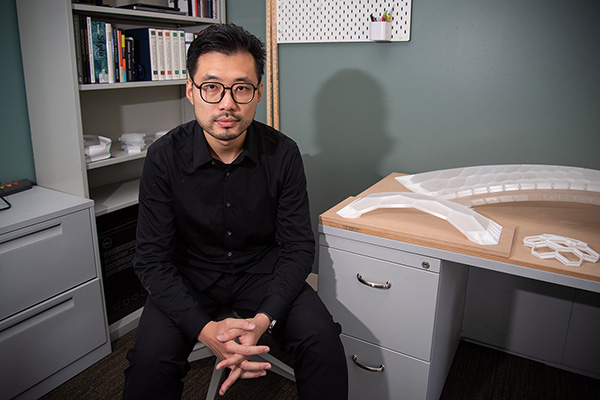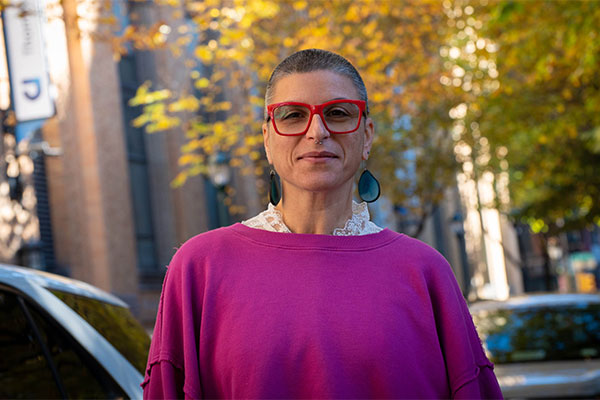A Lifelong Journey in AI
Professor Les Sztandera has been interested in AI since elementary school. Now, he’s passing his knowledge to the next generation of students.
The 2020’s may be the decade of artificial intelligence (AI), but Les Sztandera, PhD, has been immersed in the field for a lot longer than that. A professor of Computer Information Systems, he works on a wide range of topics, from exploring cost-saving measures for diabetics with eye issues to investigating the relationship between COVID-19 and eviction rates in Philadelphia. Despite the diversity of his research, the common thread is AI — a technology he sees as a powerful tool for solving real-world problems, especially in health and well-being.
Equally important to Sztandera is involving students in research. Whether mentoring PhD candidates working on AI-driven medical advancements or guiding undergraduates exploring computational intelligence, he believes that hands-on experience is key to shaping the next generation of AI researchers. In this Q&A, Sztandera discusses the potential of AI to improve lives, dispels common misconceptions about the technology, and shares how his students continue to inspire him in his work.
How would you describe your research to the person riding the elevator with you?
Since joining Thomas Jefferson University in 1993, I have been striving to provide excellence in computational intelligence research. From the beginning of my academic career, my aim has been to engage students (at both undergraduate and graduate levels) in data science and AI research. Currently, I am involved in two research projects. The first is about being prepared for the next pandemic, and the second focuses on sustainable technology that mimics nature. All my research has focused on applying AI and machine learning techniques to solve health and wellbeing issues.
Tell me about your research to prepare for the next pandemic.
It’s a Pfizer research grant that aims to comprehensively describe the long-term outcomes of COVID-19 in the Rwandan population. We are particularly interested in identifying modifiable factors that may contribute to health problems after COVID-19 infection, also known as long COVID. Importantly, this study will not only provide quantitative results but also include a qualitative investigation of long COVID perspectives and experiences of Rwandans. As the African point of view has yet to be investigated, this study will bridge gaps in our understanding of COVID-19.
What about your project to create biomimetic technology?
The second project is a research challenge, where I serve as a Jefferson faculty research lead to create a large-scale interior architecture object that changes shape when exposed to moisture. Graduate students are developing a foam that is like a breathing tapestry set of panels — sort of a living mosaic. It will be used for passive interior moisture management to ensure thermal comfort. The research is based on the concept of “biomimicry,” as it utilizes what nature has perfected over millions of years, and it uses the same processes to solve human problems and meet human needs. Thus, it allows humans to be more efficient, resilient, and sustainable in their working environments.
What first sparked your interest in AI?
I was fascinated by the potential of AI as far back as grade school. Specifically, I wondered whether and how AI could model human cognition, including human consciousness. If self-reference was captured as a form of awareness, then it would pave the way for mathematical foundations of the theory of consciousness. And, here we are today, with AI ever evolving, entering, and living in every aspect of our lives.
What’s one myth about AI you want to dispel?
AI has become a buzz phrase these days, and many people are afraid of it. Yet for me, I’ve always thought of it as “a little help from your friend” that can solve community and social challenges nationally and globally. However, it’s key that we use human empathy, derived and coming from communities experiencing the issues, to guide AI in solving those very problems.
There are a lot of students interested in learning about AI. How do you involve students in your research?
Graduate and undergraduate students are a big part of many of my projects. My current 2024-25 PhD student in Cell Biology and Regenerative Medicine is working on developing a faster and more efficient approach to ensure that radiation therapy patients are getting precise and safe treatments. Traditional methods, while effective, are time-consuming and may not fully account for patient-specific variability and real-time treatment adjustment. To address these limitations, we’re applying new machine-learning and deep-learning algorithms. Overall, Jefferson students and alumni know their communities by heart, and they embed Jefferson’s mission to impact hundreds of thousands of lives by tackling their community’s issues. This sentiment, brought into the classroom and my course projects, resonates particularly well with me in my research pursuits.
What is your best memory from teaching?
After just two and a half years of starting at Jefferson in March 1996, I managed to secure a National Science Foundation (NSF) grant aimed at exposing undergraduates to molecular modeling, computational chemistry, and artificial intelligence. Through the grant, undergraduate students at Jefferson were able to learn and see the applications of AI in daily activities. We applied algorithms to improving things we interact with, such as the clothes we wear. AI was able to alert us, even then, about carcinogenic dyes being used in coloring textiles and materials, and suggest healthier and more environmentally friendly alternatives.
What’s something you’re passionate about outside of your research?
Traveling and exploring different cultures is my second true passion. I have travelled extensively and visited 72 countries on 6 continents (North America, South America, Australia, Europe, Asia, and Africa), and I will definitely one day visit the 7th continent, Antarctica, provided the ice is thick enough to land a plane there.
Who’s a role model or someone who shaped your journey?
My role model is Mendel Trachtman, my first Jefferson department chair. His motto, in bold capital letters on his office door, still guides me till this very day: “We are here because the students are here.”



